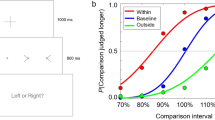Abstract
Forty male and forty female subjects were led to anticipate an interaction in which they were to take control, or were to avoid being controlled by another. Both interpersonal distances and personal spaces were greater when subjects were avoiding another's control attempts. Thus, both distance and space expand reactively in response to a threat to control. In contrast to earlier research (Edney, Walker, & Jordan, 1976), we obtained no relationship between interpersonal distance and size of personal space. The pattern of results suggests that the curvilinear relationship obtained by Edney et al. was due largely to the instructions they gave subjects regarding distance and space.
Similar content being viewed by others
Reference Note
Strube, M.J., & Werner, C. Nonverbal responses to a threat to interpersonal control and the Type A behavior pattern. Unpublished manuscript available from the authors: Psychology Department, University of Utah, Salt Lake City, Utah 84112.
References
Brehm, J.W.Responses to loss of freedom: A theory of psychological reactance. Morristown, N.J.: General Learning Press, 1972.
Cohen, J. & Cohen, P.Applied multiple regression/correlation analysis for the behavioral sciences. Hillsdale, N.J.: Erlbaum, 1975.
Cronbach, L.J., & Furby, L. How should we measure “change” — or should we?Psychological Bulletin 1970,74 68–80.
Dosey, M.A., & Meisels, M. Personal space and self-protection.Journal of Personality and Social Psychology 1969,11 93–97.
Edney, J.J., Walker, C.A., & Jordan, N.L. Is there reactance in personal space?Journal of Social Psychology 1976,100 207–217.
Hall, E.T.The hidden dimension. New York: Doubleday, 1966.
Hayduck, L.A. Personal space: An evaluative and orienting overview.Psychological Bulletin 1978,85 117–134.
Heise, D.R.Causal analysis. New York: Wiley, 1975.
Heshka, J., & Nelson, Y. Interpersonal speaking distance as a function of age, sex, and relationship.Sociometry 1972,35 491–498.
Hildreth, A.M., Derogatis, L.R., & Stratton, L. Body buffer zone and violence: A reassessment and confirmation.American Journal of Psychiatry 1971,127 1641–1645.
Horowitz, M.J., Duff, D.F., & Stratton, L.O. Personal space and the body buffer zone.Archives of General Psychiatry 1964,11 651–656.
Mehrabian, A. Relationship of attitude to seated posture, orientation, and distance.Journal of Personality and Social Psychology 1968,10 26–30.
Murphy-Berman, V., & Berman, J. The importance of choice and sex in invasions of interpersonal space.Personality and Social Psychology Bulletin 1978,4(3), 424–428.
O'Neal, E.C., Brunault, M.A., Marquis, J.F., & Carifio, M. Anger and the body-buffer zone.Journal of Social Psychology 1979,108 135–136.
Roger, D.B., & Schalekamp, E.E. Body-buffer zone and violence: A cross-cultural study.Journal of Social Psychology 1976,98 153–158.
Rosenfeld, H.M. Effect of an approval seeking induction on interpersonal proximity.Psychological Reports 1965,17 120–122.
Sommer, R.Personal space: The behavioral basis of design. Englewood Cliffs: Prentice Hall, 1969.
Author information
Authors and Affiliations
Rights and permissions
About this article
Cite this article
Strube, M.J., Werner, C. Interpersonal distance and personal space: A conceptual and methodological note. J Nonverbal Behav 6, 163–170 (1982). https://doi.org/10.1007/BF00987065
Issue Date:
DOI: https://doi.org/10.1007/BF00987065




